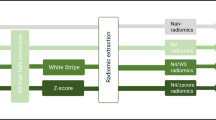Background:
Intratumoral hypoxia is associated wit poor prognosis in various solid tumors. Severe and long-lasting hypoxia results in necrosis. The presence of necrosis therefore might also be correlated with unfavorable outcome. This has been demonstrated for head and neck cancer, gliomas and adult soft tissue sarcomas. We have investigated whetehr or not the pattern of contrast enhancement and the presence of visible necrosis on pretreatment MR images has prognostic impact in Ewing tumors.
Patients and Methods: From December 1993 through March 1997, 79 patients with Ewing tumors were prospectively analyzed for the presence and amount of necrosis in their tumors. The median age was 12 years (range 4–30 years). The median follow-up at the time of this analyses was 3 years. All patients were treated according to the multicentric EICESS-92 protocol with multiagent chemotherapy (VACA or VAIA or EVAIA) and local therapy (radiotherapy with 50–60 Gy or surgery or surgery with pre- or postoperative irradiation with 45–50 Gy). For the measurement of necrosis, gadolinium contrast-enhanced T1-weighted MR images were used. Necrosis was defined as non-perfused areas in the tumor and the necrotic volume was expressed as percentage of total volume.
Results: Out of 79 tumors, 10 (10%) showed no necrosis, 30 (38%) had 1–25% necrosis, 21 (27%) had 26–50% necrosis and the remaining 18 (23%) more than 50% necrosis. There was a correlation between tumor size and necrosis (p = 0.001): the median tumor volume increased with amount of necrosis (47 cm3 in non necrotic tumors, 59 cm3 vs 280 cm3 vs 284 cm3 for tumors with 1–25% vs 26–50% vs > 50% necrosis). Tumor site (central location vs proximal extremities vs distal extremities) had no impact on necrosis (p = 0.71). 23 out of 79 patients had metastases (M1) at the time of diagnosis. The frequency of metastatic spread increased with the amount of necrosis: 1/10 (10%) patients with non-necrotic tumors had metastases vs 7/30 (23%) vs 6/21 (28%) vs 9/18 (50%) for tumors with 1–25% vs 26–50% vs > 50% necrosis. “Unfavorable” metastatic spread (bone or multiple metastases) was only noted in patients with high amount of necrosis (> 25% necrosis) whereas even large tumors did not show unfavorable metastases if they contained no or only small amounts of necrosis. All patients with non-necrotic tumors survived event-free during the observation period. Patients with necrotic tumors had a 3-year event-free survival of 55% (p = 0.06 vs tumors without necrosis).
Conclusions: The presence of non-perfused (presumably necrotic) areas on pretreatment contrast-enhanced MR-images is associated with an increased risk of metastases, especially an unfavorable pattern of metastatic spread at diagnosis. This observation may be explained by a more aggressive biological behavior of hypoxic tumor cells. The small group of patients with non-necrotic tumors (13%) had an excellent prognosis suggesting that the absence of necrosis might be helpful in identifying a very favorable prognostic subgroup in Ewing tumors.
Hintergrund:
Der prätherapeutische Nachweis von Hypoxie und Nekrosen hat bei einigen Tumoren prognostische Bedeutung. Wir haben bei Patienten mit Ewing-Sarkomen auf prätherapeutischen MR-Aufnahmen den Nekroseanteil (= nach Kontrastmittelgabe nicht perfundierte Areale) ermittelt und untersucht, ob dieser Parameter prognostische Bedeutung hat.
Patienten und Methodik: Zwischen Dezember 1993 und März 1997 haben wir bei 79 Patienten mit Ewing-Tumoren im Rahmen der zentralen Bestrahlungsplanung in der EICESS-92-Studie prätherapeutische MR-Aufnahmen ohne und mit Kontrastmittelapplikation analysiert. Als Nekrose wurden die Tumoranteile gewertet, die nach Kontrastmittelgabe nich perfundiert waren. Der Nekroseanteil wurde als relativer Anteil des Tumorvolumens geschätzt. Das mediane Alter der 79 Patienten betrug zwölf Jahre (4–30 Jahre). Alle Patienten erhielten eine Kombinationschemotherapie (VACA oder VAIA oder EVAIA) und eine Lokaltherapie, entweder eine alleinige Radiotherapie mit 50–60 Gy oder eine prä- bzw. postoperative Strahlentherapie mit 45–50 Gy oder alleinige Operation. Die mediane Nachbeobachtungszeit betrug 3 Jahre.
Ergebnisse: 10/79 (13%) Tumoren hatten keine Nekrose, 30 (38%) waren zu 1–25%, 21 (27%) zu 26–50% und die verbliebenen 18 (23%) in mehr als 50% nekrotisch. Es bestand eine Korrelation zwischen dem Nachweis von Nekrosen und dem Tumorvolumen (p = 0,001): Das mediane Tumorvolumen stieg mit zunehmender Nekrose (47 cm3 in nicht nekrotischen Tumoren, 59 cm3 vs. 280 cm3 vs. 284 cm3 bei Tumoren mit 1–25% vs. 26–50% vs. > 50% Nekrose). Die Tumorlokalisation (zentral vs. proximale Extremitäten vs. distale Extremitäten) hatten keinen Einfluss auf die Nekroserate (p = 0,71). 23/79 Patienten hatten Metastasen (M1) bei Diagnose. Die Metastasierungsfrequenz nahm mit Nekroseanteil zu: 1/10 (10%) Patienten mit nicht nekrotischen Tumoren hatten Metastasen vs. 7/30 (23%) vs. 6/21 (28%) vs. 9/18 (50%) bei Tumoren mit 1–25% vs. 26–50% vs. > 50% Nekrosen. Ein prognostisch ungünstiges Metastasierungsmuster (ossäre Metastasen oder multipler Organbefall) wurde nur bei Tumoren mit einem hohem Nekroseanteil (> 25% Nekrose) beobachtet. Alle Patienten mit nicht nekrotischen Tumoren überlebten ereignisfei nach 3 Jahren, während Patienten mit nekrotischen Tumoren nur ein ereignisfreies 3-Jahres-Überleben von 55% aufwiesen (p = 0,06).
Schlussfolgerungen: Der prätherapeutische Nachweis von nicht perfundierten nekrotischen Tumoranteilen ist mit einer ungünstigen Tumorbiologie assoziiert. Umgekehrt haben Patienten mit gut perfundierten Tumoren eine sehr günstige Prognose.
Similar content being viewed by others
Author information
Authors and Affiliations
Additional information
Received: June 29, 2000; accepted: October 19, 2000
Rights and permissions
About this article
Cite this article
Dunst, J., Ahrens, S., Paulussen, M. et al. Prognostic Impact of Tumor Perfusion in MR-Imaging Studies in Ewing Tumors. Strahlenther Onkol 177, 153–159 (2001). https://doi.org/10.1007/s00066-001-0804-8
Issue Date:
DOI: https://doi.org/10.1007/s00066-001-0804-8




